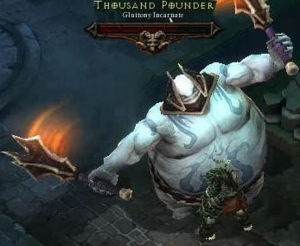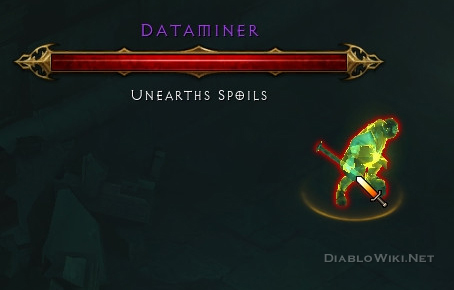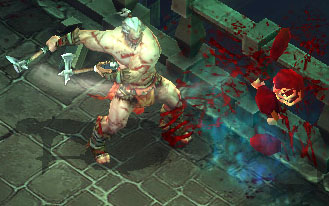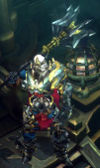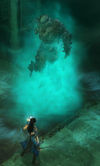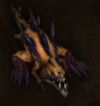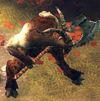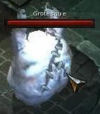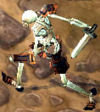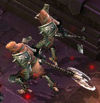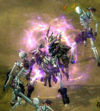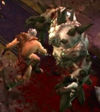Monster
Monsters are one of the main attractions in Diablo III, or at least the opportunity to kill them is. See the Monsters Category for a listing of all the known monsters in Diablo III. There is also a brief list below. In addition to monsters, there is more of the basic Diablo III information available in the Diablo 3 Basics article.
Bosses and champions are found in Diablo 3 as they were in the previous games in the series, and are the real focus of most reward/difficulty to be found during combat.
Contents
- 1 Development
- 2 Classifications
- 3 Monster Types
- 4 Resistances and Immunities
- 5 Bosses
- 6 Behavior/AI
- 7 Deaths
- 8 Component System
- 9 List of Known Monsters
- 9.1 Bosses
- 9.2 Standard Monsters
- 9.2.1 Activated Vessel
- 9.2.2 Berserker
- 9.2.3 Crawling Torso
- 9.2.4 Cultist
- 9.2.5 Dark Demon
- 9.2.6 Dark Vessel
- 9.2.7 Dune Thresher
- 9.2.8 Fallen Shaman
- 9.2.9 Ghostly Orb
- 9.2.10 Ghoul
- 9.2.11 Goatman
- 9.2.12 Goatman Shaman
- 9.2.13 Grotesque
- 9.2.14 Lamprey
- 9.2.15 Savage Beast
- 9.2.16 Scavenger
- 9.2.17 Skeleton
- 9.2.18 Skeletal Archer
- 9.2.19 Skeletal Executioner
- 9.2.20 Skeletal Shieldman
- 9.2.21 Skeletal Summoner
- 9.2.22 The Unburied
- 9.2.23 Walking Corpse
- 9.2.24 Wood Wraith
- 9.2.25 Wraith
- 9.2.26 Wretched Mother
- 9.2.27 Zombie
Development[edit | edit source]
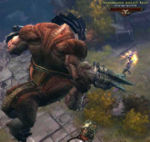
The D3 team has created a huge variety of monsters for our slaughtering pleasure, and the denizens of the underworld are customized, personalized, and quite versatile. Bosses have been greatly upgraded in appearance and size, and the AI has been improved as well, but unfortunately they are not the main targets for item hunting anymore. This is a big departure from previous Diablo games, and was received with worse than mixed reception.
As the D3 Team describes it, the monsters and characters evolve at the same time, feeding off of each other. Jay Wilson described this process in a December 2008 interview.[1]
- "...the monster design. As we get further and further into the game, our goal is to make monsters that we can't figure out how the player can defeat [with the existing skills] and give the player the tools they need to defeat them. So the design of the monsters has a direct relationship to the design of the classes. That's kind of an ongoing thing; we [decide] "Let's create a monster that has really debilitating rooting attacks that just get you stuck when you encounter them." Then we see that this really screws with the Barbarian, so we give him a skill that lets him break out of roots so that he can counter that. Those things are interesting and allow for the player to have a broader, deeper character. On the other hand, we don't want to go too far -- a lot of mechanics of World of WarCraft are based heavily on control, and we want to make sure that Diablo 3 stays mostly a combat game based mostly on attacks.
In an interview from October 2009, Leonard Boyarsky described the monster design process in more detail. [2]
- Leonard Boyarsky: A lot of the monster design stems from what is needed from a gameplay perspective. So different guys from our team from different disciplines like art, design, effects… will get together and will call a strike team and will really kind of brainstorm what would be cool to fit this niche in the game that we know we need. In the broadest sense we’ll know we’ll need let’s say a ranged monster, we’ll know we’ll need a monster that casts buffs on other monsters, and how can we bring something original to that. How can we make that an interesting character, or interesting monster. And then, a lot of the times the artists will give a personality or a kind of feel to those monsters and then we’ll come in and work with them on the lore.
- What we wanna do for a lot of the stuff is decide whether it’s from the lore side of the demons – whether it’s naturally occurring, and then we’ll try to come up with backgrounds for those different things. And sometimes, we’ll have the idea for, well, you’re in this area so this is the kind of... from a lore standpoint this is the kind of monsters or the kind of animals that you’d encounter, but we really don’t put any kind of requirements in terms of the gameplay of them. We could say, “Oh, you’re gonna run into a goatman here, or whatever” and then they will be able to run with that, because it’s pretty wide open, you know you can do a lot of different stuff with the characters.
Monster Shape, Color, and Silhouette[edit | edit source]
Blizzard's designers work hard to give the monsters distinctive shapes, colors, and outlines, so they'll be recognizable at a glance, even through the busiest of on-screen action. This slide from a panel at Blizzcon 2009 shows the distinctive design of D2 and D3 monsters.
Classifications[edit | edit source]
We're grouping monsters as they were sorted in Diablo II, as Animals, Demons, or Undead. At this point, this is purely for ease of organization. It's not known how monsters will be grouped in the final game, and/or if the familiar aspects of their types, such as undead taking extra damage from blunt weapons, will be retained in Diablo III. This information will be added to the wiki as soon as Blizzard makes it available. Consider all these classifications as tentative, for now.
Classification by Function[edit | edit source]
The Diablo design team classifies monsters by their function, with all monsters grouped into a few types, depending on their AI. The design goal is to group different types by how they best cooperate with each other, and you'll see the same types of monsters together in different areas throughout the game.
- Swarmer: Weak. Typically melee.
It's a lot of fun to fight tons of little monsters at once. These function basically as "health walls," giving the players something to kill and gather health orbs from. They're not really meant to be dangerous.
- Ranged: Projectile speed. Arc. Direct.
Most dangerous type other than bosses, since they can all attack you at once. Unlike melee enemies. Ranged may employ some evasive movement AI as well, rather than just running in to die like swarmers.
- Lieutenant: Resurrecting. Buff. Spawners.
These are higher level monsters that can cast spells or share abilities with the swarmers and ranged lesser monsters. They can resurrect, buff, spawn, etc. They're not in large numbers, but are high priority targets.
- Elite: Tough. Stronger attacks. Or both.
Designed to make the player pause and think. High damage attack, high hit points, etc. Something different. Scary and dangerous, more so than the lieutenant.
- AOE: (Area of Effect). Point blank, line, radial, cone.
Area of Denial characters. Change the "game space." Set the ground on fire, make player move. Mix up the gameplay. The description terms refer to the types of shapes their spells can create, thus forcing the player to avoid or play differently than normal.
- Weakener: Debuff. Slow. Drainer.
Kind of like Lieutenants, but they make swarmers and ranged guys more threatening.
- One offs: Sleeper, Alarm, Bee Hive, Linked, Sapper, Thief
Various monsters that have cool abilities. Jay Wilson purposely didn't explain what they were, saying he wanted fans to have fun debating them.
Monster Types[edit | edit source]
It's not yet known how monsters are classified in Diablo III. There are monsters seen in the early screenshots and gameplay movie that look to be animals, and quite a few undead, and others that might be demons, but there's no telling if that Diablo II classification system will be reused in Diablo III. We're tentatively referring to the monsters by their apparent demon/undead/animal genus, for the sake of easier organization, but do not take that as evidence that they'll be sorted by those types in the game.
Resistances and Immunities[edit | edit source]
The D3 Team is not planning to grant many immunities to monsters in Diablo 3. They want enough resistances to require characters to use more than one type of attack all the time, but they don't want to make some monsters too hard for particular characters to deal with. Jay Wilson elaborated on this in a November 2009 interview. [3]
- Jay Wilson: We aren't looking to have full immunities or anything of the sort; however we are considering keeping one-element immunities on enemies. Because of the way our skill system works it's almost impossible to build a character that won't have some alternate skill to attack an enemy. So then it becomes an interesting use of a skill or skills that you may not be using all the time. We think that's interesting and fun gameplay, to have to adapt to situations. The adaptation just shouldn't be realizing your character or class is broken and you have to run away or you need to get in a multiplayer game. Those are things we intend to avoid forcing the player into.
Bosses[edit | edit source]
From what players saw during the Blizzcon 2008 and 2009 demos, bosses in Diablo 3 are much as they were in Diablo 2. SuperUniques in a few set, scripted locations, with lots of champions and random bosses (with random modifiers) scattered around the rest of the game world.
No players have yet seen any Act Bosses, with even the mighty Siegebreaker Assault Beast from the WWI 2008 gameplay movie (who was 10x larger than any monster in Diablo 2) said to be a not especially impressive enemy, taking the game as a whole.
- See the bosses page for many more details and comments from the development team on this issue.
- See the Boss Modifiers page for the 20~ known special modifiers bosses can spawn with; many more than in Diablo II.
Superuniques[edit | edit source]
A Superunique is a specific kind of monster in Diablo III. They are displayed with their names in purple, have set spawn locations, and are often part of a quest or event. They will have special attacks such as Vampiric, Knockback and Jailer. While some superuniques are always found on given locations (e.g. Odeg the Keywarden always appears somewhere in the Fields of Misery), others only spawn occasionally. The probability of finding some is really low and encountering them can require hundreds of attempts. This is why the "A Unique Collection" achievement is one of the hardest to complete in Diablo III.
List of Superuniques.
Champions[edit | edit source]
There are several types of champions in Diablo 3, much as there were in Diablo 2. These are monsters that spawn alone or in small groups, and are less powerful than bosses, but much stronger than normal monsters. See the champions page for more details.
Known types of Diablo 3 Champions:
- Champions
- Fanatics
- Possessed
- Frenzied
Behavior/AI[edit | edit source]
Monsters are going to be smarter and more varied in their behaviours in Diablo III. The D3 Team wants to force players to play smarter, and use tactics other than simply rushing to kill the monsters as soon as they are sighted. So some creatures have very powerful attacks that need to be avoided, others work very well in groups, others run away if threatened or only attack in packs, and so forth.
Deaths[edit | edit source]
The D3 Team has repeatedly talked about the fact that monsters in the Diablo series are chiefly defined by their entrances and their exits. Creatures don't live for very long, so what they do in life is less memorable than how they appear, and how they die. This issue came up in Blizzcast #8. [4]
- Bashiok: Julian back to you, one of the major effects systems is the death system which kind of goes over how monsters die. Which is one of the cooler parts of the game, and we’ve seen a little bit of that before at WWI and BlizzCon, but what is the system and can you explain it to those listening and what does it do in the game?
- Julian: Yeah, something pretty close to my own heart there. We recognized that monsters really live to die in Diablo. We developers don’t have a lot of time to express their personality, or much time to make the character's experience with monsters meaningful. Most of what players are doing is killing them. So one of the things we were interested in doing during development was making as many different ways for monsters to die as possible. So that was kind of the goal, and think we’re up to something like 35 ways for any given monster to “bite it” at this point.
- The basic theory is to really extend on the idea that Diablo II started with, which was that you would hit monsters and you would see the damage you did to them reflected on them. And we said, well let’s take that further, monsters could burn to death when you hit them with a fiery sword, and then we added the idea of crits and monsters could explode across the screen, and it just kind of went from there. But that’s essentially the idea.
Special Death Animations[edit | edit source]
Monsters that die to a critical hit get a special "critical death" animation, which is extra gory. The monsters literally explode, leaving chunks of themselves scattered across the ground. These animations are customized for whatever type of damage killed them; the chunks have flames licking across them from fire damage, sparks and arcs from lightning, etc. Physical damage critical deaths tend to leave huge slicks of blood, and give a battlefield a lovely post-massacre patina.
These special deaths are even extended to individual skills, with acid spells causing them to dissolve, Locust Swarm bugs eating them down to their bones, Disintegrate turning them to ash, and many others. Lots of these effects were demonstrated during a panel at BlizzCon 2008, an lovely excerpt from which you can view below:
Component System[edit | edit source]
This term referred to the way monsters of the same type in Diablo II could appear different. Skeletons spawned with different types of weapons, armor, shields, and so forth, just to give the demonic legions some variety in their appearance. The different equipment wasn't purely superficial either; it went along with logical changes to the monster's damage or defense.
This technique is being used in Diablo III, and while details haven't yet been revealed, the team has mentioned their plans to use graphical tweaks and palette shifts to give the monsters some variety.
List of Known Monsters[edit | edit source]
Here is a list of all the monsters in brief. Click on their names for further information about them.
Bosses[edit | edit source]
Bosses were technically called "SuperUniques" in Diablo II. We're calling them Bosses in Diablo III, just for the sake of simplicity.
Siegebreaker Assault Beast[edit | edit source]
"Living siege Engine of Hell". The Siege Breaker is an absolutely massive "miniboss" shown in the WWI 2008 gameplay video. It's apparent that Blizzard is taking the gameplay with even the minor bosses to a whole new level in Diablo III! We don't know if he's a random encounter or not, but this big bad-ass is found in Leoric Highlands.
Thousand Pounder[edit | edit source]
Inside the Forgotten Tombs of the WWI 2008 gameplay video, we got familiar with the Thousand Pounder as he was summoned in to the scene. He's also seen in concept art work, and looks more like an overly powerful monster than an actual type of boss, like a SuperUnique.Leoric[edit | edit source]
The Skeleton King returns in Diablo III, and he's up to his old skeleton-summoning tricks. He's found sitting on his throne, must be awakened by the use of a quest item, and does not return in a good mood. Leoric wields a gigantic hammer and commands a vast army of the undead. He is a quest boss and was the final creature to defeat in the Blizzcon demo build (October 2008.) See The Skeleton King quest article for more details.
Standard Monsters[edit | edit source]
Even the "standard" monsters of Diablo III comes in many different shapes and forms, and employs different types of obstacles for the player.
Activated Vessel[edit | edit source]
Scary looking humanoid demonic creation made from willing Dark Vessels. Activated Vessels are mutated, half-demonic things who fight furiously and move very quickly. It's a good idea to kill off the Dark Vessels before they can activate, if at all possible.
Berserker[edit | edit source]
Berserkers are the muscle of their evil, demon-worshiping cult. They are massive, powerful men who wear hoods and loincloths and carry huge mauls, with which they are happy to bash your brains in. Berserkers have a special overhead smashing attack, which they telegraph by powering up their mauls with a reddish glow. Their overhead attack is highly damaging, but if you dodge it the Berserker will hit the floor so hard their maul breaks through the stone and gets stuck there.
Crawling Torso[edit | edit source]
Crawling Torsos are one of the more disturbing monsters we've yet seen. They are the upper half of a Walking Corpse, a type of zombie. If the walking corpse is killed with a powerful hit, it will die completely. If it's only hit with a glancing blow though, it will break in half, and the upper body will become... A crawling torso.
Cultist[edit | edit source]
Cultists are human mages who spawn with Berserkers. Cultists are very weak, but they can shoot fireball projectiles and summon powerful Dark Demons, so it's wise to bypass the hulking Berserkers to kill the Cultists as quickly as possible. Cultists can be recognized from Dark Vessels by their lack of a staff. Vessels have a long staff which curls at the end, on which they lean while summoning up the demons by which they are possessed.
Dark Demon[edit | edit source]
These odd, half-skeletal creatures are summoned from raw, red manhole-like openings in the ground by Dark Cultists. They are quadrupedal, and look a bit like a dog crossed with a crocodile, then turned inside out. They are quick of foot, but appear to possess only melee attacks.
Dark Vessel[edit | edit source]
These human mages are commonly found standing motionless, amidst various other types of Dark enemies. Vessels are harmless in their human form, but become very dangerous melee fighters if they manage to pull a demonic entity into themselves. In that form they are known as Activated Vessels, and are ferocious fighters. Dark Vessels look a bit like Dark Cultists, but Vessels lean on tall crooks, and remain motionless until they transform, while Cultists are mage-like enemies who cast a variety of spells and summon demons.
Dune Thresher[edit | edit source]
Dune Threshers are apparently mostly located north of Caldeum, which would imply that the game will take us to the surrounding desert areas. They are the croco-sharks of the sand, and is a great threat to anyone wandering in the desert. Well, besides heroes like the average player in Diablo III. Above two primary front legs these beasts are equipped with a second pair of appendage in the form of gigantic talons that supplement its leap-and-bite attack. The beasts are very fast and most dangerous.
Fallen Shaman[edit | edit source]
Fallen Shamans return in Diablo III, but none have yet been seen in screenshots. We only know of them thanks to this animated gif, which Blizzard's D3 Community Manager, Bashiok, had as his forum avatar. Fallen were in D1 and took on an expanded role with new AI, shamans, and grouping habits in D2 (Diablo 2 Fallen). How they'll progress in D3 remains to be seen, but everyone seems to like this monster type, so their return is a popular one.
Ghostly Orb[edit | edit source]
Ghostly Orbs are a sort of monster generator, creating a wraith every few seconds until they are destroyed. They've only been seen in the WWI 2008 gameplay movie, when four of them emerge from the floor in a trapped room and begin producing wraiths as soon as they are active.
Ghoul[edit | edit source]
These swarming monsters appear to be the zombie cannon fodder of Diablo III. They are blue-skinned undead who spawn in great numbers, are quite fleet of foot and quick of movement, but are fairly weak and easy to kill. Ghouls can be seen climbing up the walls and swarming the Barbarian in the beginning of the WWI 2008 gameplay movie. They die almost as fast as they race to battle (which is quite quickly).
Goatman[edit | edit source]
The goatmen foot soldiers seen thus far are much as they were in Diablo II. They mill around in medium-sized packs, wielding huge two-handed polearms, and attack quickly, but not very effectively. The D3 goatmen have quick footspeed and a fast swing, but they pause for a long time between attacks. Their death sounds seem to be improved over how they were in D2, though they're not quite as delightfully bleaty and goaty as they were in D1, when their enticing noises put them amongst everyone's favourite monsters to kill. In Diablo III they finally received a proper backstory though...
Goatman Shaman[edit | edit source]
Though goatmen were a popular monster in D1 and D2, the Goatman Shaman is a new unit, and nothing is yet known about its abilities. Presumably it will be able to buff goatmen in various ways, and perhaps heal or even resurrect them as well. It is known that the shaman have intelligent AI; one in the WWI 2008 gameplay movie runs when its herd is wiped out by a Witch Doctor's Wall of Zombies, finds a new pack of goatmen, and takes up a position behind them.
Grotesque[edit | edit source]
One of the more interesting monsters seen in the WWI 2008 movie, the Grotesque are basically living pinatas. They are fat, white, humanoid monsters, who either don't have an attack or a very weak one. What they do instead is run up to a player who comes into range, take a few hits, bend over backwards, and rupture into a massive fountain of wriggling silver eels called Lamprey. There seem to be far more eels within a grotesque than their volume would permit, but such is the nature of magic.
Lamprey[edit | edit source]
Lamprey are squirming eels that emerge in a flood from a ruptured Grotesque. They are not powerful monsters, but are disgusting in their fecundity and must be stomped out, like giant maggots.
Savage Beast[edit | edit source]
Savage Beasts are large, buffalo-like herd beasts seen in the plains areas of Diablo III. They have a very fast charging attack, and gore with their huge tusks up close, though the few seen in the WWI 2008 gameplay movie died pretty easily. They're not just animals either; they've been mutated by Diablo (or someone?) to become monstrous.
Scavenger[edit | edit source]
The scavenger returns from Diablo I, and it's taken on some properties of the Leapers from Diablo II. They look more like animals than demons, and are somewhat badger-like in their furry, striped appearance. But they leap and dart around wildly, and seem quite capable of swarming an unwary hero by sheer numbers.
Skeleton[edit | edit source]
As iconic as zombies, animated human skeletons have been featured in all of the Diablo games, and just about every other fantasy RPG ever made. In D3, plain skeleton warriors are joined Skeletal Summoners, Skeletal Archers, and Skeletal Shieldman, and (perhaps) other types not yet revealed.
Skeletal Archer[edit | edit source]
The basic bones with a bow, Skeletal Archers return for their third go 'round in the Diablo series, and they are much as they've ever been. A humanoid skeleton with a bow and a relatively slow firing rate. They are not dangerous one on one, but a pack of them can be pretty nasty, especially against low armor or stationary targets.
Skeletal Executioner[edit | edit source]
Skeletal Executioners are a larger, more powerful version of skeletons, instantly recognizable by their red hoods, huge shoulder pads, and the massive headsmen axes. They only pick up the axes when they are about to use them, and they use both arms to deliver vicious overhead chops with their weapons. Skeletal executioners have a short range charge attack that they finish with a devastating chop of their axes. Being hit by one won't actually kill a character in a single blow, but it's quite painful.
Skeletal Shieldman[edit | edit source]
Skeletal Shieldmen spawn with large, round, glowing blue shields from which they derive their names. They carry a sword as well, but use it only sporadically, and not with very great effect. Their chief purpose is as a defensive unit, and a phalanx of these skeletons can usually be found in front of Skeletal Archers or a Skeletal Summoners. They block very effectively, thwarting most attacks launched straight at them, but are very slow to turn and can be flanked or simply run past without much difficulty.
Skeletal Summoner[edit | edit source]
These skeleton shaman spawn with packs of Skeletal Archers and Skeletal Shieldman for protection. The Summoners are larger than regular skeletons, and have glowing purple/pink orbs around their upper bodies. These may be shields, decoration, or an indication what type of elemental damage they deal. During battle the summoners stay to the rear of their foot soldiers, where they keep busy summoning fresh skeletons, or hurling purple projectiles at any players who stray into range.
The Unburied[edit | edit source]
These huge, hulking, spike-covered monsters are undead; the largest type of undead ever seen in any of the Diablo titles. They are slow of foot and hard-hitting, much like the club-wielding Blunderbores seen in Diablo II. The only Unburied yet seen were early in the game, during the demo levels available at Blizzcon 2008, and were not too nasty. It's expected that we'll find more dangerous varieties of them later in the game, since that's how the monsters in Diablo III roll.
Walking Corpse[edit | edit source]
These slow moving zombies are a bit larger than the base model, and can presumably take a bit more punishment. They are a very similar creature though, shambling around aimlessly, too stupid to use weapons or spells, only dangerous in large groups. Walking corpses have a unique talent, in that upon death they sometimes break in half, but continue the battle as their upper bodies snap off and become a Crawling Torso.
Wood Wraith[edit | edit source]
The only type of this monster yet seen is called the Wood Wraith, but they are called Gnarled Walkers in the concept art, and that seems a more likely name for the entire monster type. Gnarled Walkers are not just living, Ent-like trees, but are demonic, possessed um... trees. From the concept art they look to be things, mad plants, rather than individual entities. They do not have faces, and they are not bipedal bodies formed from wood. They are literally demonic trees, soulless and mindless and deformed by the dark magics that have animated them.
Wraith[edit | edit source]
Wraiths return in Diablo III, and while their function looks about the same, their graphics have been substantially improved. They were seen emerging from Ghostly Orbs in the WWI 2008 movie, and it's not known if they can only come from those odd monster generators, or if they'll be found roaming (floating) freely in the dungeons as well. Wraiths have a melee slashing attack, and a ranged life drain attack as well. That one has a lovely graphic, with a swirling stream of blueish vapour flowing from the character to the Wraith.
Wretched Mother[edit | edit source]
These zombies appear to be a slight upgrade from the generic, brains-loving shamblers. They look somewhat gothic and have the ability to summon more undead by regurgitating dead bodies.Zombie[edit | edit source]
Zombies return to Diablo III in much the same form as they occupied in Diablo I and Diablo II. Humanoid, slow, shambling, and just generally unpleasant. Their slow speed and negligible intelligence makes them perfect targets for new characters to warm up and level up against.| Beta Content A significant portion of this article deals with development / pre-release / Beta content. A request has been made for it to be updated. List of Beta Content Pages |
| Monsters of Diablo III[e] Beasts Beasts: Superunique Demons Demons: Superunique Humans Humans: Superunique Undead Undead: Superunique Objects Bosses Boss Mods Monster Info Fanmade |
|---|
| Beasts | Bat - Beast - Blood Hawk - Demonic Hellflyer - Electric Eel - Khazra - Lacuni - Lamprey - Quill Fiend - Rockworm - Sand Monster - Sand Shark - Sand Wasp - Scavenger - Spider - Spiderling - Swarm - Withermoth - Wood Wraith - |
|---|
| Demons |
Armored Destroyer - Dark Berserker - Deceiver - Fallen - Ghoul - Hellion - Thrall |
|---|
| Undead |
Accursed - Bone Reaver - Brigand - Dune Dervish - Ghost - Ghoul - Grotesque - Morlu Caster - Risen Dead - Skeleton - Skeleton Mage - Unburied - Wraith - Wretched Mother |
|---|
| Primary Quest Uniques |
Act One Bosses:
Araneae -
Skeleton King -
The Warden -
The Butcher
|
|---|
|
| |||||
|---|---|---|---|---|---|
| Uniques Modifiers |
Strong CC (Limit 1): Knockback -- Nightmarish -- Vortex -- Jailer | ||||
| Removed Modifiers |
| ||||
|
| |||||
| Act One Uniques | Araneae - Web Spit | Leoric - Summon Skeleton, Teleport Strike, Triple Cleave | The Butcher - Smash, Grappling Hook, Spear, Frenzy Charge | ||
| Act Two Uniques | Maghda - Forcefield, Summoning Ritual, Punish, Moth Dust, Teleport. | Zoltan Kulle - Fiery Boulder, Time Bubble, Ceiling Collapse, Energy Twister,Vanish, Creepy Laugh | Belial - Phase One: Triple Fireball, Summon Vipers. Phase Two: Poison Meteors, Ground Pound, Lightning Strike, Lightning Breath. | ||
| Act Three Uniques | Ghom - Acid Slime, Sneeze, Gas Cloud, Chomp. | Siegebreaker - Triple Hit, Charge, Leg Stomp, Grab and Throw. | Cydaea - Pain Bolts, Web Trap, Spider Pits. | Azmodan - Bellyflop, Laser Attack, Falling Corpses, Demon Gate, Pool of Destruction, Globe of Annihilation. | |
| Act Four Uniques | Rakanoth - Cleave, Teleport Strike, Blade Strike, Volley, Summon Minion. | Izual - Frost Nova, Frozen, Summon Minions. | Diablo - Phase One: Claw Rip, Charge, Hell Spikes, Shadow Vanish Grab, Curse of Destruction, Ring of Fire, Ground Stomp, Curse of Anguish, Curse of Hatred. Phase Two: Shadow Clone. Phase Three: Overdrive, Lightning Breath. | ||
| Monster Info |
Monsters Basics -
Bosses -
Boss Modifiers -
Champions -
Quest bosses -
Teeth of Diablo -
Fan-made monsters
|
|---|

